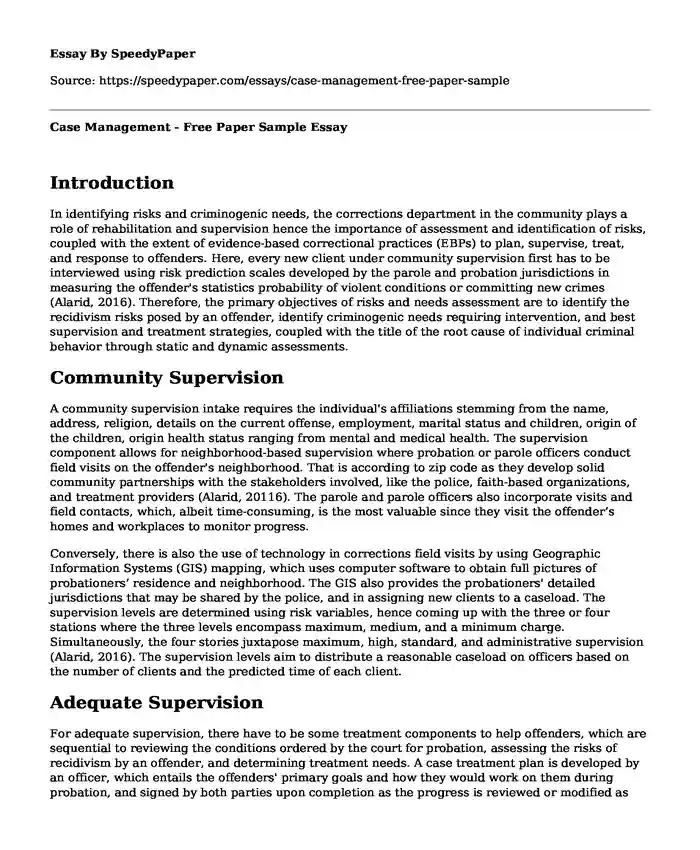
| Type of paper: | Essay |
| Categories: | Community Risk management |
| Pages: | 3 |
| Wordcount: | 589 words |
Introduction
In identifying risks and criminogenic needs, the corrections department in the community plays a role of rehabilitation and supervision hence the importance of assessment and identification of risks, coupled with the extent of evidence-based correctional practices (EBPs) to plan, supervise, treat, and response to offenders. Here, every new client under community supervision first has to be interviewed using risk prediction scales developed by the parole and probation jurisdictions in measuring the offender's statistics probability of violent conditions or committing new crimes (Alarid, 2016). Therefore, the primary objectives of risks and needs assessment are to identify the recidivism risks posed by an offender, identify criminogenic needs requiring intervention, and best supervision and treatment strategies, coupled with the title of the root cause of individual criminal behavior through static and dynamic assessments.
Community Supervision
A community supervision intake requires the individual's affiliations stemming from the name, address, religion, details on the current offense, employment, marital status and children, origin of the children, origin health status ranging from mental and medical health. The supervision component allows for neighborhood-based supervision where probation or parole officers conduct field visits on the offender's neighborhood. That is according to zip code as they develop solid community partnerships with the stakeholders involved, like the police, faith-based organizations, and treatment providers (Alarid, 20116). The parole and parole officers also incorporate visits and field contacts, which, albeit time-consuming, is the most valuable since they visit the offender’s homes and workplaces to monitor progress.
Conversely, there is also the use of technology in corrections field visits by using Geographic Information Systems (GIS) mapping, which uses computer software to obtain full pictures of probationers’ residence and neighborhood. The GIS also provides the probationers' detailed jurisdictions that may be shared by the police, and in assigning new clients to a caseload. The supervision levels are determined using risk variables, hence coming up with the three or four stations where the three levels encompass maximum, medium, and a minimum charge. Simultaneously, the four stories juxtapose maximum, high, standard, and administrative supervision (Alarid, 2016). The supervision levels aim to distribute a reasonable caseload on officers based on the number of clients and the predicted time of each client.
Adequate Supervision
For adequate supervision, there have to be some treatment components to help offenders, which are sequential to reviewing the conditions ordered by the court for probation, assessing the risks of recidivism by an offender, and determining treatment needs. A case treatment plan is developed by an officer, which entails the offenders' primary goals and how they would work on them during probation, and signed by both parties upon completion as the progress is reviewed or modified as per the change of circumstances (Alarid, 2016). Besides reducing opportunities for crime, a case treatment plan aims to minimize barriers that may result in recidivism and accelerate positive behavioral change for the offender, including placement on a treatment program.
A total of eight principles of effective correctional intervention encompass cognitive behavioral therapy, employment assistance, developing networks of prosocial, filed notes. There is also working with female offenders, early pathways to women criminality, gender-specific programs, motivational intervention, the principle of responsivity, and rapport (Alarid, 2016).
Conclusion
Finally, working with female offenders requires knowledge of the potential pathways to the crime that may be invoked by a lack of education opportunities, domestic violence, sexual and physical abuse, substance abuse problems, among others. Therefore, women's supervision calls for empathy and si8imultenously, helping them change the mentality off their victims, become responsible and empowered.
Reference
Alarid, L. (2016). Community-based corrections. Cengage Learning.
Cite this page
Case Management - Free Paper Sample. (2023, Nov 24). Retrieved from https://speedypaper.net/essays/case-management-free-paper-sample
Request Removal
If you are the original author of this essay and no longer wish to have it published on the SpeedyPaper website, please click below to request its removal:
- Baltimore City Neighborhood Overview, Essay Example
- Essay Sample on Role of Risk Assessment
- The 10 Project Management Knowledge Areas - Essay Sample
- Essay Sample on Education Development Strategies
- Speech and Text Analysis - Free Essay Example
- Amazon: A Global Retail Giant with 4 Pillars of Success - Essay Sample
- Free Paper Sample: Effects of COVID-19 Crisis to Instruction in College Campuses
Popular categories




